The Google Pixel XL Review: Life After Nexus
by Matt Humrick & Brandon Chester on November 8, 2016 8:00 AM EST- Posted in
- Smartphones
- Mobile
- Snapdragon 821
- Pixel
GPU Performance
Section by Brandon Chester
The Pixel XL's Snapdragon 821 SoC uses the same Adreno 530 GPU that is used in Snapdragon 820. In the case of MSM8996 Pro AB, the max GPU frequency is set at 624MHz, which is also the same as Snapdragon 820. This means that at least on paper, one can expect the same GPU performance from the Pixel XL as existing Snapdragon 820 devices. Of course, there are always improvements to drivers and to the SoCs themselves as the manufacturing process matures, so there's always room for improvements in peak and sustained performance, but there won't be any major gains like what one would see from a completely new GPU or a bump in peak clock speed on the same part.
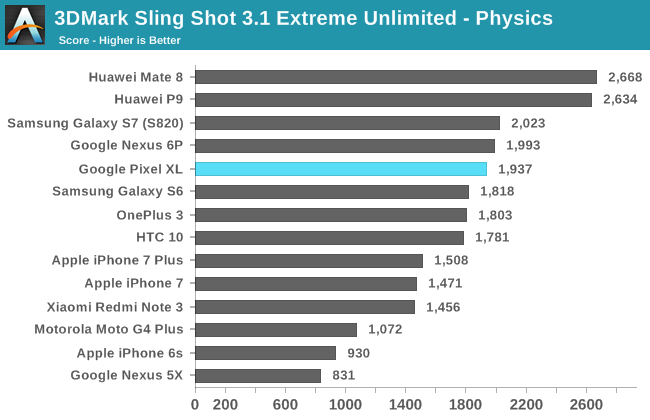
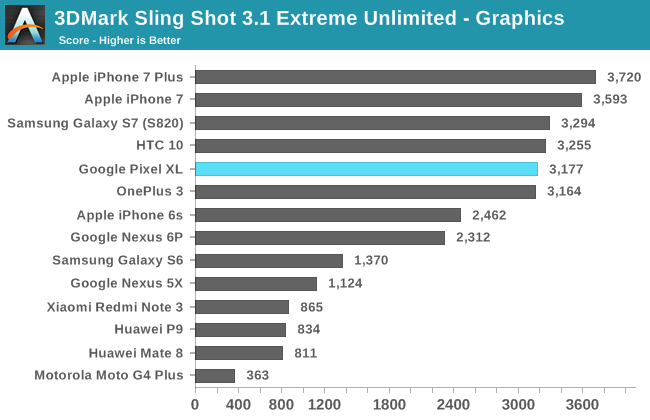
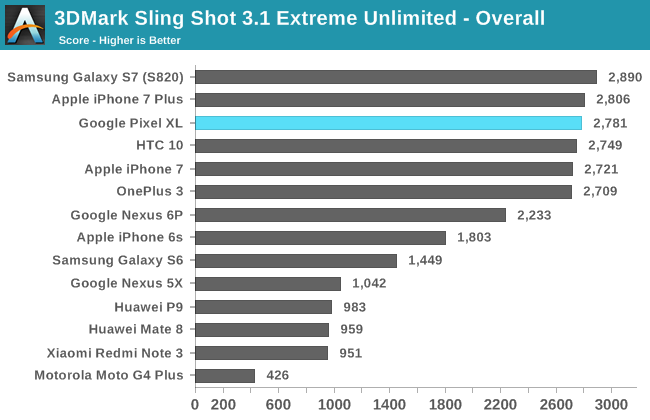
The Pixel XL performs similarly to existing Snapdragon 820 devices in 3DMark Sling Shot. All the devices from the past twelve months generally achieve the same overall score in this test, although when you look at the separate graphics and physics scores you'll see that some devices do better in each category than others. There's not much else to say here, as the Pixel XL isn't breaking any new ground, but it's also not behind the other Android flagship competition either.
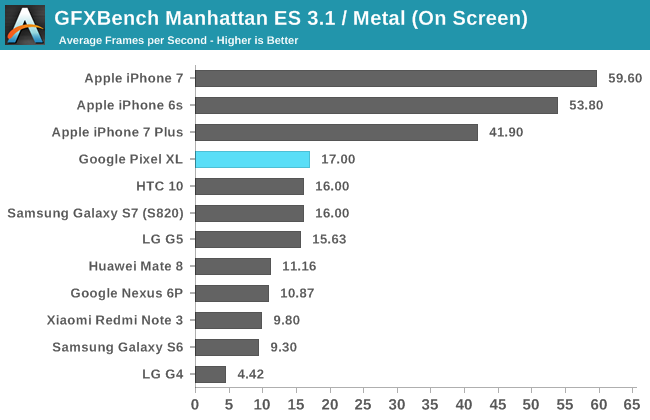

As expected, the performance of the Pixel XL in GFXBench's Manhattan test is in line with existing Snapdragon 820 devices. This year devices have really standardized on a resolution of 2560x1440 and Snapdragon 820, so the Pixel XL's performance in both tests is essentially identical to other phones such as the HTC 10 and the Galaxy S7. It's hard to overlook the fact that the Pixel XL's performance is competitive with smartphones that launched in the first quarter of the year, while the most recent smartphones like the iPhone 7 and 7 Plus are over 30% faster in this test despite being the same price.
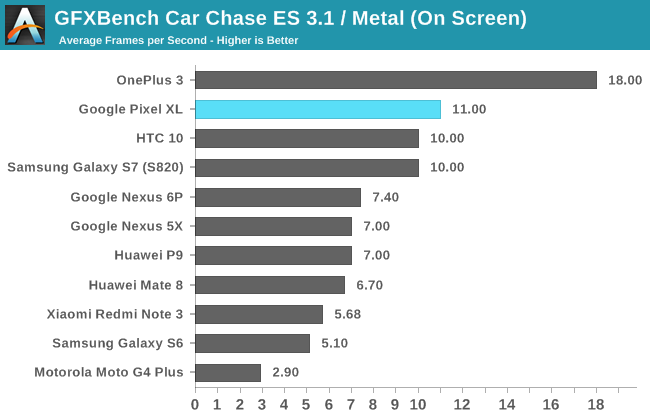
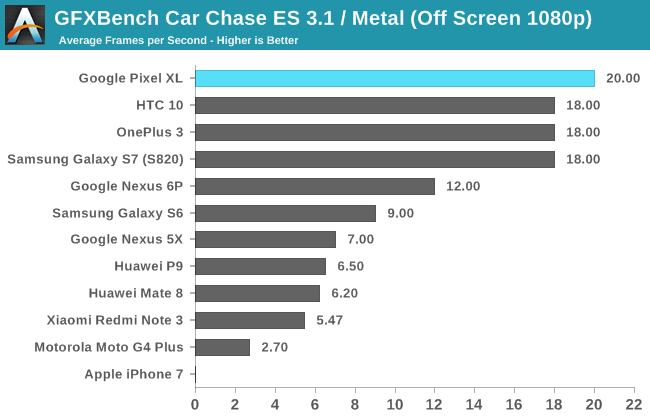
In Car Chase the situation is essentially the same as Manhattan, with the Pixel XL performing similarly to existing Snapdragon 820 devices. In both cases the performance is actually a bit better, but not significantly so. The OnePlus 3 pulls ahead of the Pixel XL in the on screen test, which makes sense given that it's a 1080p device sitting among 1440p devices. Car Chase isn't available on iOS so there's no way to compare to Apple's A10, but among Android devices the Pixel XL does provide the best GPU performance available right now.
The Pixel XL's GPU performance is in line with the current flagship Android phones. Of course, it's already November, so it won't be too long before we see the next generation of phones arrive. Launching this late into the year means that performance isn't going to be significantly better than the initial wave of Snapdragon 820 devices that have been available since February or March, which does put the Pixel in a bit of an awkward position as far as price is concerned. You can grab a OnePlus 3 for $399 and it will perform equally as well in GPU-bound applications as the Pixel, or you can spend the same amount as the Pixel on an iPhone and GPU performance is significantly better. Whether or not this matters really depends on the customer, but it's something to consider when considering the balance of performance and features relative to the cost of a device.










250 Comments
View All Comments
BMNify - Tuesday, November 8, 2016 - link
Anandtech might have accidentally used the HDR+ On mode instead if the Auto HDR+ mode recommended by Google (and selected by default)BMNify - Tuesday, November 8, 2016 - link
*instead ofMatt Humrick - Tuesday, November 8, 2016 - link
Yes, there is a difference in how the camera works when using "HDR+ auto" vs "HDR+ on." Thanks for pointing that out. I've updated the review to explain the difference in performance.djayjp - Tuesday, November 8, 2016 - link
No app cold and warm start-up times test? :/Ryan Smith - Tuesday, November 8, 2016 - link
Unfortunately Android 7 breaks DiscoMark, and we don't have a suitable replacement at this time.realbabilu - Wednesday, November 9, 2016 - link
Someone has been testing it manually. It coherent with Anandtech findings on Discomark bench. Most of QHD phones not speedy enough as FHD phone like Oneplus 3 or even Xiaomi lowprice phone. Take a look here : Pixel XL vs iphone7 https://www.youtube.com/watch?v=Na0JRDMAoKM , and iPhone 7 vs Oneplus 3. https://www.youtube.com/watch?v=KuXvCN8A7GQfanofanand - Tuesday, November 8, 2016 - link
I miss you already Nexus. Google had catered to people like myself who wanted solid specs with a reasonable price in a reasonably solid enclosure. I will not be chasing them to the high-end. I can appreciate those with fat wallets doing it, but I think it's ridiculous to spend $700+ every 2 years replacing a handset. There are way too many options in the $200-300 range to waste so much cash on a device like this.frozenwilderness - Tuesday, November 15, 2016 - link
technically you wouldn't be spending a full $700 every 2 years, assuming you sell your old phone in good condition, it'd probably only come out to around $400 or so every 2 yearsfanofanand - Tuesday, November 15, 2016 - link
I checked swappa to see how accurate your claim is, and a two year old Galaxy S5 is selling for roughly $115. Better check your math again.asublimeday - Tuesday, January 3, 2017 - link
Samsungs have notoriously poor resell rates. It's the constant BOGO and free phone deals they offer. Drives their rates wayyyy down. iPhones and Nexus/Pixels tend of offer deals less frequently and hold their value better.